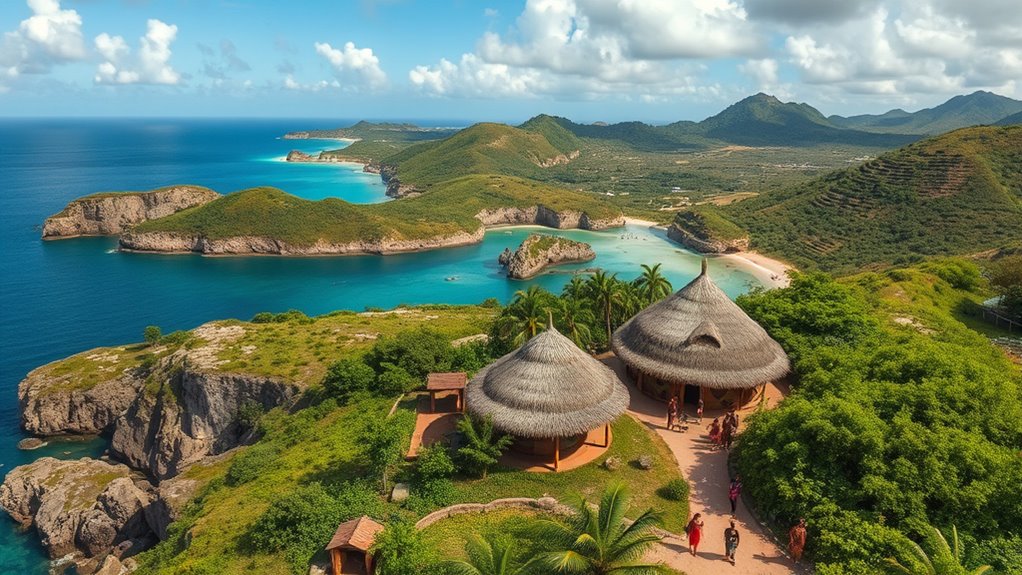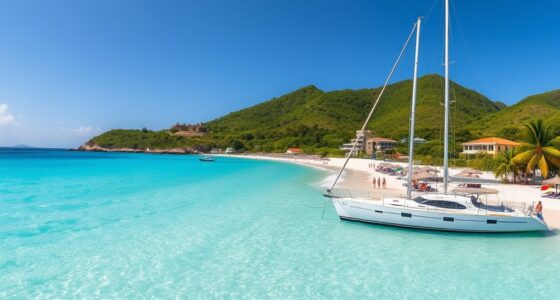Antigua and Barbuda’s history begins with the indigenous Siboney and Arawak peoples who shaped its early culture through hunting, fishing, and pottery. European explorers arrived in the 15th century, but it wasn’t until the 17th century that the British established a colony, transforming the islands with sugar plantations and enslaved Africans. After slavery ended in 1834, communities fought for rights and independence, which they gained in 1981. Discover how these events and cultural traditions continue to influence the islands today.
Key Takeaways
- Antigua and Barbuda’s history began with indigenous Siboney and Arawak peoples, whose cultural legacies are evident today.
- European colonization, primarily by the English from 1632, significantly shaped the islands’ social, political, and economic development.
- The rise of the sugar economy, fueled by enslaved African labor, deeply influenced Antigua’s social structure and cultural heritage.
- Post-emancipation struggles led to community activism, labor movements, and eventual push for independence in 1981.
- The islands’ rich cultural identity blends indigenous, African, and European influences, reflected in traditions, art, and oral histories.
Early Inhabitants and Indigenous Heritage

Antigua’s earliest inhabitants were the Siboney people, often called the “Stone People,” who settled the island as early as 2400 BC. You’ll find that the Siboney relied heavily on hunting, fishing, and gathering for survival, leaving behind shell tools and pottery. Their presence marked the beginning of human activity on the island, shaping its early cultural landscape. As time progressed, the Siboney were gradually replaced by the Arawak peoples from Venezuela, who migrated through the Lesser Antilles around 1000 AD. The Arawaks introduced new farming techniques and pottery styles, contributing to Antigua’s indigenous heritage. These early peoples laid the foundational cultural practices that would influence later inhabitants, creating a rich tapestry of history that you can still trace today through archaeological sites and oral traditions. Additionally, ongoing archaeological discoveries continue to shed light on their artistic expressions, helping us understand their cultural significance.
European Encounters and Colonial Foundations

After the island’s early inhabitants established a foundation of cultural practices, European explorers arrived, marking a new chapter in Antigua’s history. You’ll see that this encounter introduced lasting change, shaping the island’s future. First, the Spanish sighted Antigua in 1493, naming it after Santa Maria de la Antigua, but didn’t settle due to resistance. Second, attempts by Spain and France to establish colonies failed, mainly because of Carib opposition and scarce resources. Third, the English finally settled in 1632 under Thomas Warner, establishing the first successful colony. This shift set the stage for European influence on Antigua’s social, economic, and political structures, laying the groundwork for the island’s colonial identity and its complex history of conquest, resistance, and adaptation.
The Rise of the Sugar Economy and Slave Society

The rise of the sugar economy transformed Antigua from a modest colony into a thriving center of wealth and commerce. You see, Sir Christopher Codrington’s establishment of large sugar estates in 1674 shifted the economy’s focus. To meet demand, enslaved Africans were forcibly brought in by the thousands, forming the backbone of this lucrative industry. Sugar cultivation required intensive labor, which led to the development of a harsh slave society marked by brutal conditions and resistance. As the industry expanded, so did Antigua’s wealth, with forts built to defend these valuable assets. The sugar economy’s growth brought prosperity to planters and increased dependence on enslaved labor, shaping Antigua’s social and economic landscape for generations. This period also saw the emergence of slave society structures that deeply influenced the island’s cultural and demographic makeup.
Struggles for Freedom and Post-Emancipation Changes

Despite the abolition of slavery in 1834, freedom did not immediately translate into economic or social equality for formerly enslaved people. You face ongoing struggles to gain land, credit, and respect in a plantation-centered economy. Your community organized protests and labor unions to demand better conditions, highlighting resistance against lingering oppression. To understand this era better, consider:
Freedom after 1834 didn’t erase the fight for land, dignity, and fair treatment.
- The limited economic opportunities and landownership challenges for freedpeople.
- The rise of labor unions, like the Antigua Trades and Labor Union, advocating for workers’ rights.
- The social and political activism that laid the groundwork for independence and racial equality.
- The role of labor movements in shaping post-emancipation society and advocating for workers’ rights.
These efforts reflect your resilience and determination to reshape Antigua and Barbuda’s future beyond slavery’s shadow. Your collective actions fostered a sense of identity and paved the way for societal change.
Political Development and Paths to Independence

Political development in Antigua and Barbuda accelerated as residents organized for greater self-rule, culminating in the formation of political parties and labor unions that challenged colonial authority. In the 1930s, unions like the Antigua Trades and Labor Union gained momentum, advocating for workers’ rights and political representation. These organizations helped mobilize public support for self-determination. Throughout the mid-20th century, leaders like Vere Cornwall Bird emerged, pushing for independence and national sovereignty. The push for political reform gained urgency as economic hardships worsened and colonial governance faced increasing pressure. A significant factor in this movement was the rise of civil society organizations, which played a crucial role in advocating for political change. By the late 1970s, negotiations with Britain intensified, leading to constitutional reforms. Ultimately, Antigua and Barbuda achieved full independence on November 1, 1981, establishing a sovereign government rooted in democratic principles.
Cultural Identity, Festivals, and Modern Heritage

Cultural identity in Antigua and Barbuda is a vibrant reflection of their African, Caribbean, and colonial heritage, shaping everyday life and community values. You’ll find this rich mix expressed through lively festivals, music, dance, and art. To deepen your understanding, consider:
- The Antigua Carnival, a colorful celebration of emancipation, featuring masquerade bands, calypso, and soca that showcase African roots and Caribbean vibrancy.
- Barbuda Caribana, highlighting indigenous traditions, dance, and storytelling that preserve pre-colonial cultural practices.
- Modern heritage sites like museums and historic landmarks that connect you to the islands’ colonial past and the resilience of their people.
- The cultural expressions of Antigua and Barbuda continue to evolve, reflecting both their rich history and contemporary influences, fostering a dynamic sense of identity.
Frequently Asked Questions
What Are the Origins of Antigua and Barbuda’s Creole Language?
You might notice that Antigua and Barbuda’s Creole language blends African, European, and Caribbean influences. It developed through the interactions of enslaved Africans, colonizers, and indigenous peoples during the colonial era. Enslaved Africans brought their languages, which mixed with English and other European languages spoken by colonizers. Over time, this mixture evolved into the Creole dialect, serving as a cultural identity and a way to communicate among diverse communities.
How Did Natural Disasters Influence Antigua’s Historical Development?
Imagine a hurricane tearing through Antigua in 1847, destroying crops and infrastructure. Natural disasters like this hurricane disrupted the sugar economy, causing economic decline and hardship. You see, these events forced residents to adapt, diversify livelihoods, and rebuild. Over time, repeated disasters reshaped the islands’ development, pushing them toward tourism and other industries, reducing reliance on sugar and fostering resilience in the face of nature’s fury.
What Role Did Pirates Play in Antigua’s Colonial History?
Pirates played a significant role in Antigua’s colonial history by threatening sugar plantations and trade routes. You’d see forts like Fort George built to defend these valuable assets from pirate attacks. Pirates also contributed to the island’s reputation as a strategic prize, influencing colonial defenses and economic stability. Their presence forced settlers to develop stronger fortifications and shaped Antigua’s reputation as a Caribbean pirate hotspot during the colonial era.
How Has Cricket Shaped Antigua’s National Identity Over Time?
Cricket has been a essential thread woven into Antigua’s national fabric, uniting communities and fostering pride. You witness local heroes inspiring youth and bringing people together during matches at iconic venues like Sir Vivian Richards Stadium. The sport’s influence extends beyond the field, shaping cultural expressions, celebrations, and a shared identity rooted in resilience and excellence. Cricket’s legacy helps you see Antigua’s spirit shining brightly through every spirited game.
What Are the Traditional Crafts and Arts Unique to Antigua and Barbuda?
You’ll find that Antigua and Barbuda have vibrant traditional crafts like colorful beadwork, woven baskets, and handcrafted pottery. You can also see the skillful making of vibrant textiles and embroidered items that reflect African and Caribbean influences. Local artisans often create jewelry from shells and seeds, showcasing their connection to the sea and nature. These crafts are essential to cultural expression and are celebrated during festivals and markets across the islands.
Conclusion
As you explore Antigua and Barbuda’s rich history, remember it’s like a vibrant tapestry woven with threads of resilience, freedom, and cultural pride. Each tradition and festival symbolizes a chapter in your island’s story—a beacon guiding future generations. Embrace this heritage as a lighthouse illuminating your path forward, reminding you that even in challenges, the enduring spirit of your ancestors continues to shine brightly, shaping a future rooted in history’s profound lessons.










